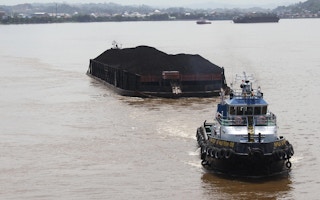Major flooding from just a few hours of heavy rain in Samarinda, Indonesia’s coal-mining capital, has underscored the severity of the environmental degradation being carried out by the industry, officials and activists say.
The city, the largest on the island of Borneo, was paralysed by floods on Dec. 27 and again on Jan. 11, both times a result of heavy rainfall washing into the Mahakam River unchecked from deforested mining concessions upstream.
“The main cause of flood is coal mines,” said Muriono, an official from the disaster mitigation agency, or BPBD, in East Kalimantan province, of which Samarinda is the capital. “There are many mining pits that are left unmonitored and even abandoned. The result is the destruction of the environment because the ecology is disturbed and not rehabilitated.”
The Mining Advocacy Network (Jatam), an independent watchdog, says there are more than 10 mining companies operating just upstream of Samarinda, which sits at the mouth of the Mahakam River. Their activities have turned the once forested landscape of the upstream area into a barren wasteland dotted with abandoned mining pits, Jatam says, and as a result the upstream area can no longer absorb large volumes of rainfall.
“Samarinda is an area that receives rainwater runoff from other areas, such as Kutai Kartanegara district” further inland, said Pradarma Rupang from the East Kalimantan chapter of Jatam. “Water from both illegal and legal mining concessions around Samarinda’s borders will end up in Samarinda.”
The mining companies have been getting away with razing the forests for years because the local government turned a blind eye to their activities, Pradarma said.
“It’s an old song that keeps repeating,” he said. “Flooding is an old problem and the cause has been mentioned, but there’s no effort to improve [the situation] by the Samarinda municipal government.”
“
There are many mining pits that are left unmonitored and even abandoned. The result is the destruction of the environment because the ecology is disturbed and not rehabilitated.
Muriono, an official from the disaster mitigation agency or BPBD
The mines have also undermined the capacity of another river in the area, the Karang Mumus, and the Benanga dam that sits on it, Pradarma said. At least 20 mines operate around the dam, he said, most of them illegal.
Wahyu Widhi Heranata, the head of the East Kalimantan mining agency, said these companies had left behind at least four mining pits. When it rains, the runoff carries mud from these sites and into the river, exacerbated by the deforestation that means there’s no vegetation to stop the topsoil from also washing away. Over time, both the river and the dam silt up, rendering them shallower and reducing their capacity to absorb large volumes of water.
The dam’s reservoir today has a capacity of just 500,000 cubic meters (132 million gallons), or just over a third of its designed capacity of 1.4 million m3 (370 million gal.).
“Samarinda no longer has a water catchment area,” Pradarma said. “The capacity of the Benanga dam and the Karang Mumus River that’s meant to [contain runoff] doesn’t function well.”
Hendra A.H., the secretary of the BPBD, said the problem was exacerbated by the proliferation of settlements along the banks of the Karang Mumus, as well as the indiscriminate dumping of trash into the river, further constricting its flow. Nearly 45 per cent of the streams and other waterways passing through Samarinda have disappeared, replaced by settlements, according to the city’s public works agency.
“We can see now that the Karang Mumus River has already narrowed,” Hendra said. “There’s a lot of trash and the catchment soil doesn’t function because it has turned into settlements.”
He said both the Karang Mumus River and the Benanga dam had to be dredged, and the latter widened, to boost their capacity to collect and store runoff water.
“Samarinda citizens [also] have to be aware to not throw their trash [in the river],” he said. “If these things [are addressed], then Samarinda will slowly be free from floods.”
This story was published with permission from Mongabay.com.










